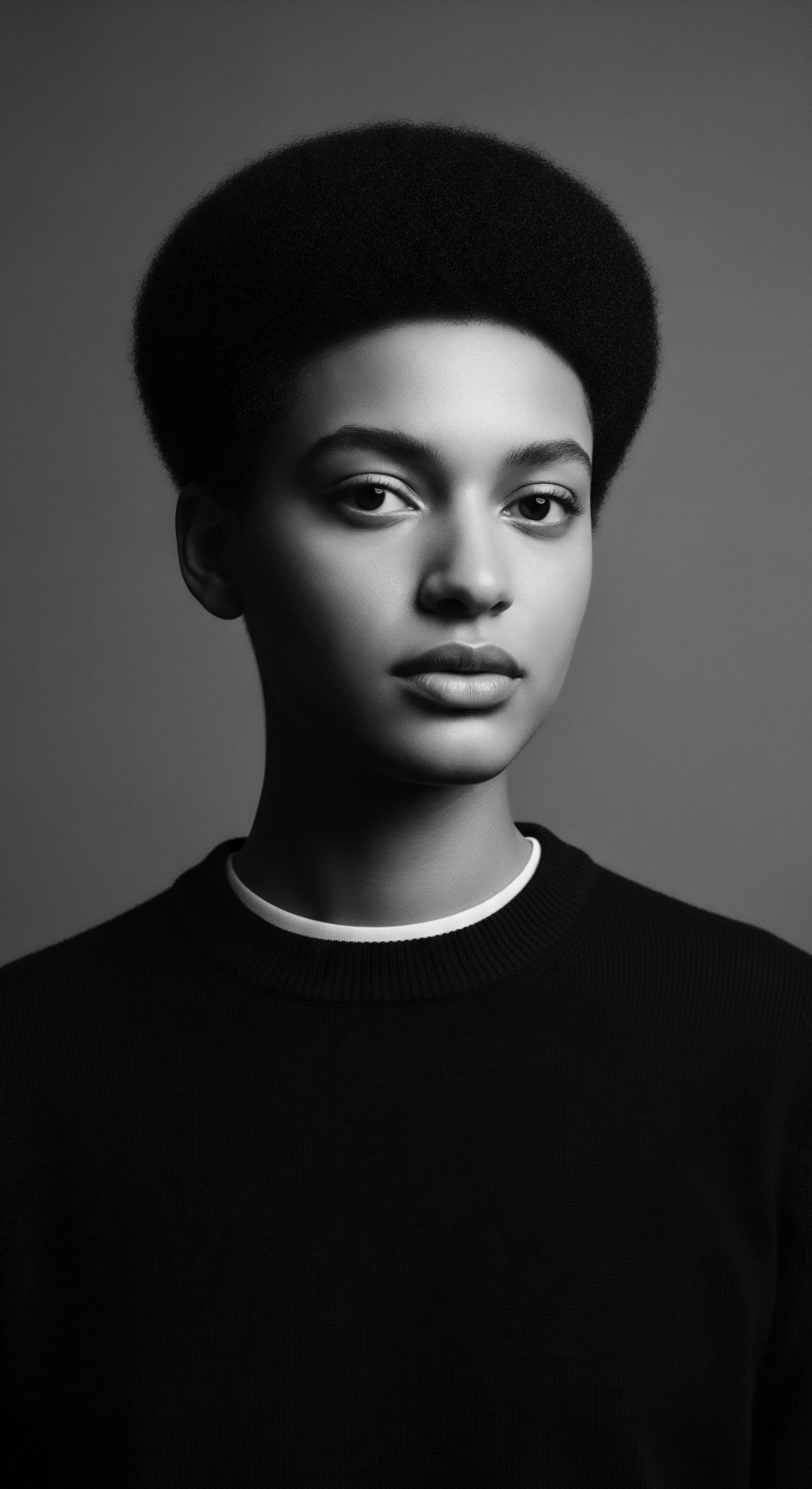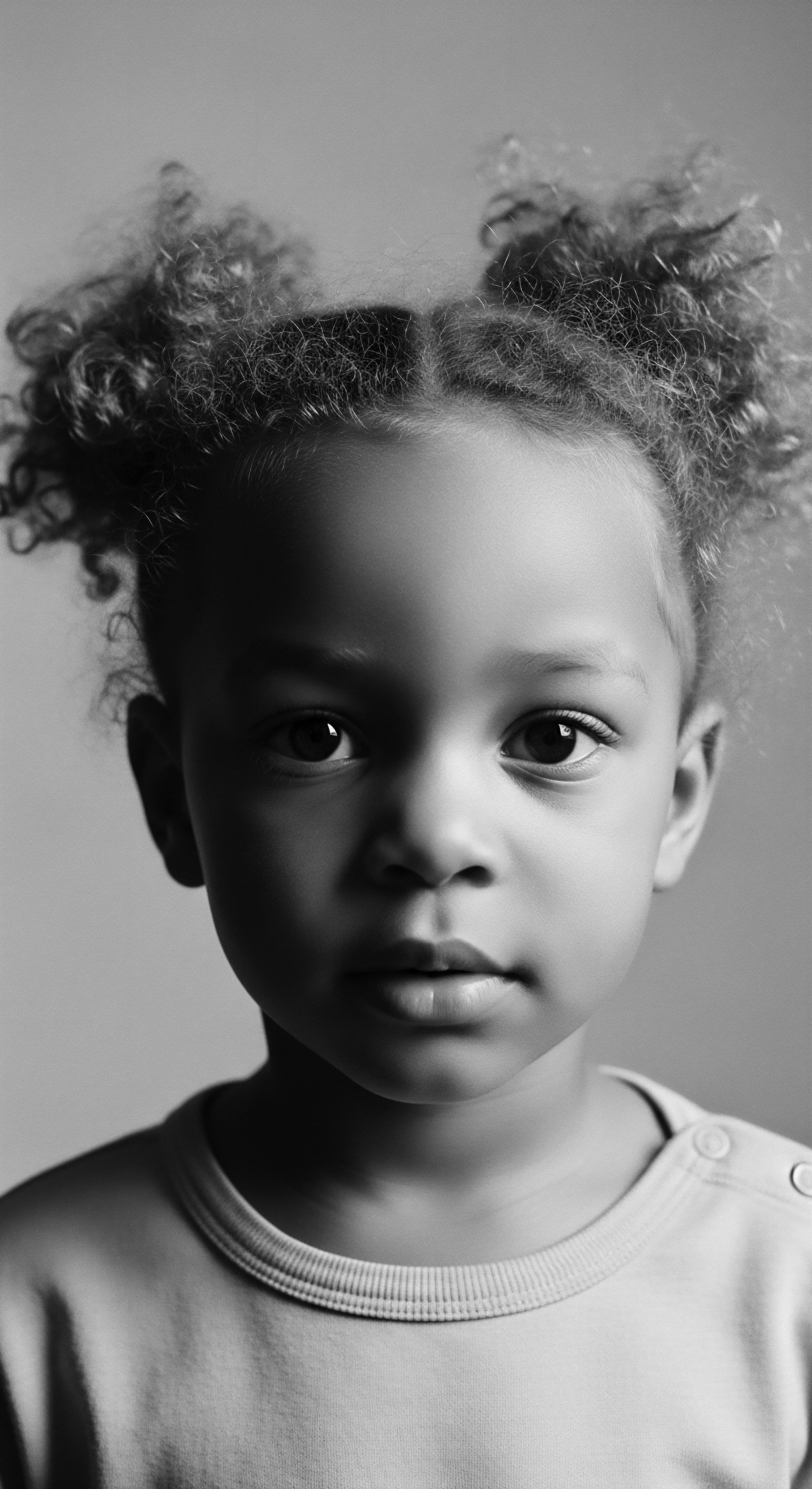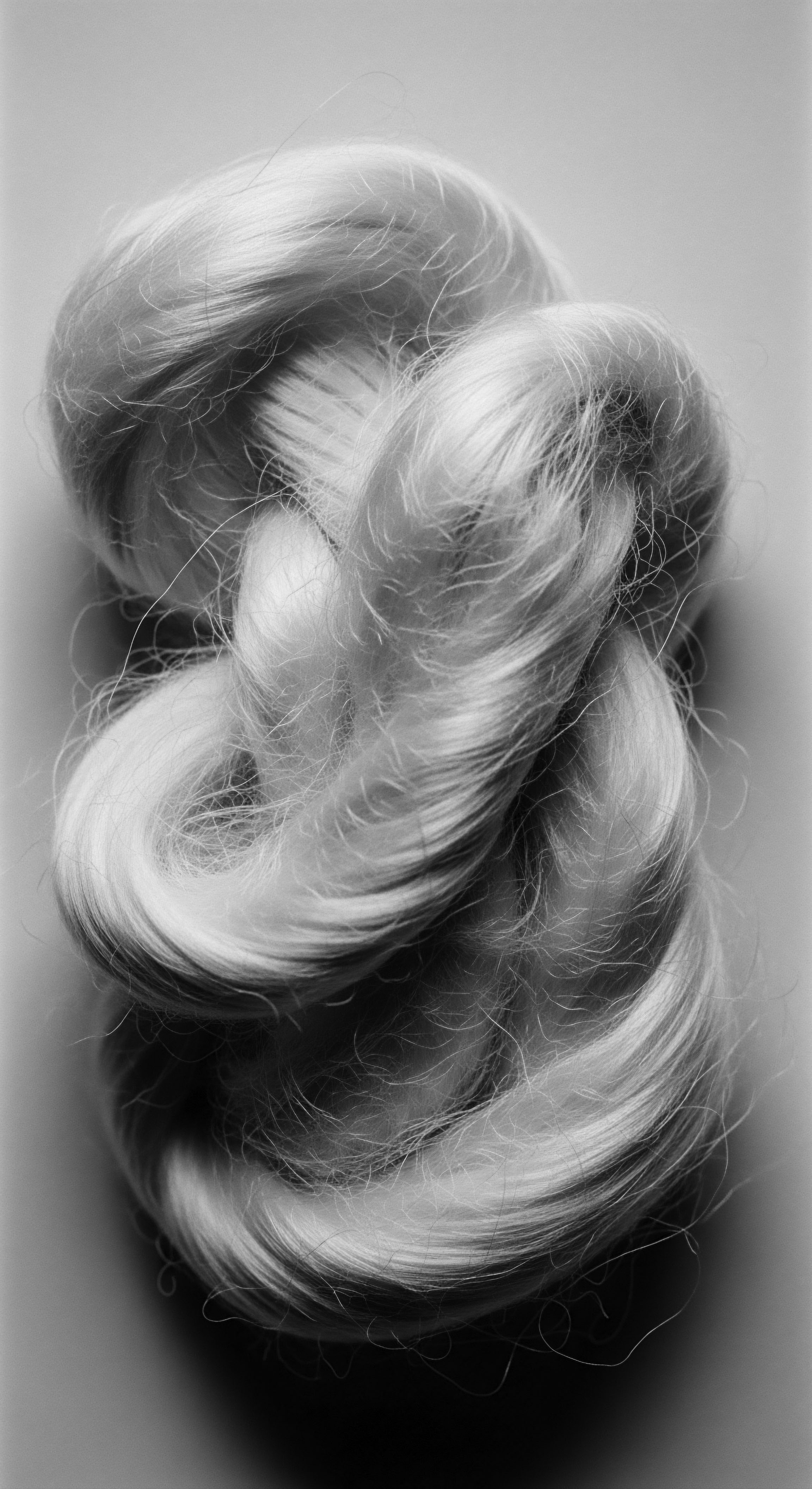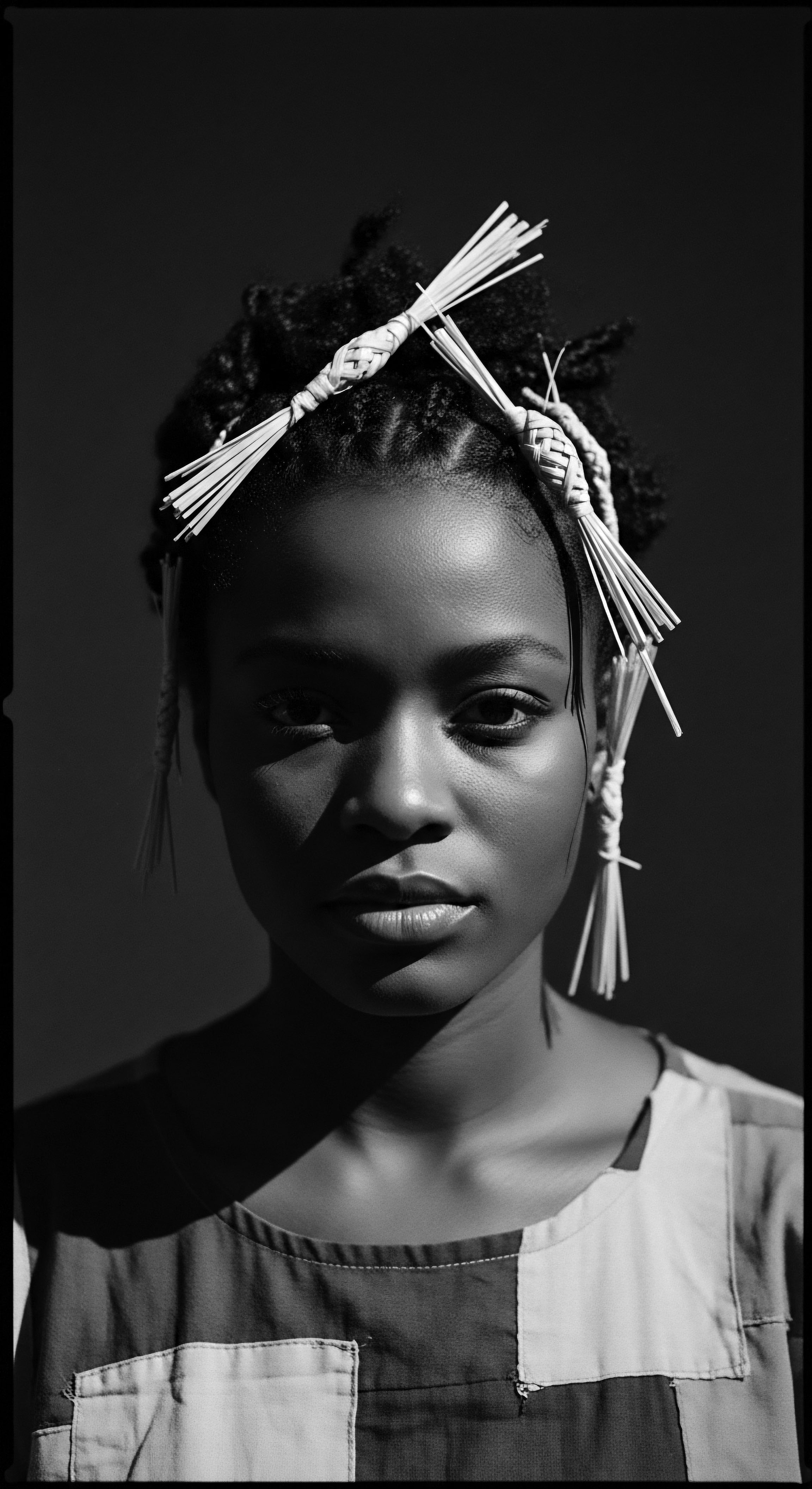
Fundamentals
Within the sacred expanse of Roothea’s living library, where every strand tells a story of lineage and resilience, we approach the subject of Keratin Degradation not merely as a scientific phenomenon but as a profound echo across generations. At its fundamental core, Keratin Degradation describes the structural breakdown of Keratin, the very protein that forms the foundational architecture of hair. This resilient protein, a complex arrangement of amino acids bound together, gives hair its strength, its spring, and its ability to withstand the myriad forces it encounters daily. When these intricate bonds begin to unravel, the hair fiber weakens, losing its inherent vitality and its protective shield.
Hair, a silent witness to our journeys, relies upon the integrity of its keratin structure for its very existence. The outermost layer, the Cuticle, composed of overlapping scales, acts as a protective armor, guarding the inner cortex. The cortex, rich in keratin, provides the hair with its elasticity and tensile strength. When external forces, be they environmental or mechanical, compromise this delicate balance, the keratin proteins within the hair shaft begin to fragment.
This fragmentation, a process of deterioration, is the essence of keratin degradation. It manifests as a diminishment of the hair’s natural capabilities, reducing its capacity to retain moisture and resist breakage.
For textured hair, particularly that of Black and mixed-race communities, the inherent architecture presents a unique set of considerations. The natural coiling and spiraling patterns, while magnificent in their expression, mean that these strands possess fewer cuticular layers and a more elliptical cross-section compared to straighter hair types. This structural distinction, a gift of evolutionary adaptation to diverse climates, also renders textured hair intrinsically more susceptible to external stressors that precipitate keratin degradation.
The twists and turns along the hair shaft can become points of vulnerability, where the cuticle may lift more readily, exposing the inner cortex to the elements and initiating the weakening of its protein bonds. Understanding this elemental biology is the first step in appreciating the ancestral wisdom that has long guided the care of these cherished strands.
Keratin degradation is the structural breakdown of hair’s foundational protein, diminishing its strength and protective qualities.
The concept of hair’s strength and vulnerability has been understood through observation for centuries, long before scientific microscopes unveiled the precise molecular structures. Ancestral practices for hair care often revolved around preserving what was intuitively known to be the hair’s life force—its ability to retain moisture, its elasticity, and its resistance to snapping. This traditional understanding, passed down through the hands of caregivers, provided a practical response to the subtle signs of protein weakening, focusing on nourishing and shielding the hair fiber from environmental assaults.
The early understanding of keratin degradation, though not articulated in modern scientific terms, was deeply embedded in the daily rituals of communities. The sight of frayed ends or brittle strands signaled a need for specific interventions, practices that aimed to restore the hair’s supple nature. This observation-based knowledge, honed over countless generations, underscored the importance of proactive care to maintain the hair’s structural integrity, ensuring its longevity and vibrant appearance. The earliest approaches to maintaining hair health were, in effect, a collective endeavor to prevent the visible manifestations of protein deterioration.

Intermediate
Moving beyond the foundational understanding, the intermediate view of Keratin Degradation unveils a more intricate interplay of factors that compromise the hair’s core protein. This process, while a natural part of the hair’s life cycle and environmental exposure, is significantly accelerated and exacerbated by certain practices and external influences. The delicate disulfide bonds, which are the very backbone of keratin’s stability and dictate the hair’s shape, are particularly vulnerable. When these bonds are disrupted, the hair’s inherent structure is altered, leading to a loss of its characteristic strength and resilience.
One primary agent of this protein breakdown is Chemical Processing. For generations, particularly within Black and mixed-race communities, chemical relaxers were a prevalent method for achieving straightened hair textures, often driven by societal pressures and Eurocentric beauty ideals. These powerful alkaline agents, designed to alter the hair’s natural curl pattern, function by intentionally breaking a significant number of these crucial disulfide bonds. While they reshape the hair, they also leave it profoundly compromised.
Similarly, hair dyes and bleaching agents, through oxidative processes, attack and degrade the keratin structure, leading to increased porosity and a dramatic reduction in tensile strength. The hair, once vibrant, becomes more susceptible to environmental insults and mechanical stress.
Beyond chemical interventions, the application of Excessive Heat stands as another formidable foe to keratin integrity. Tools such as flat irons, curling wands, and even high-heat blow dryers, when used without proper protective measures, can cause irreversible damage to the hair’s protein matrix. The intense thermal energy denatures the keratin, causing the protein chains to unravel and the protective cuticle scales to lift or fracture. This thermal assault strips the hair of its natural moisture and lipids, leaving it dry, brittle, and prone to splitting and breakage.
Environmental elements also contribute to the ongoing process of protein weakening. Prolonged exposure to Ultraviolet (UV) Radiation from the sun, for instance, triggers a photochemical degradation of keratin. UV rays instigate the release of free radicals within the hair shaft, which then attack and degrade the protein structure, including the vital disulfide bonds. This environmental assault results in a decrease in the hair’s structural integrity, leading to a loss of its natural luster and color vibrancy.
Chemical treatments, excessive heat, and environmental exposure are primary drivers of keratin degradation, compromising hair’s structural integrity.
The historical context of hair care within Black and mixed-race communities offers a poignant illustration of keratin degradation’s pervasive impact. The advent of chemical relaxers in the mid-20th century, offering a more permanent straightening alternative to hot combs, became a widespread practice. These treatments, while offering a perceived ease of styling and conformity to prevailing beauty standards, often came at a profound cost to hair health.
The repeated application of these strong chemicals led to chronic hair damage, including severe breakage, thinning, and various forms of alopecia. This widespread experience underscores how societal pressures can inadvertently contribute to the acceleration of keratin degradation, transforming a biological process into a narrative of collective struggle and resilience.
The very structure of textured hair, with its unique coiling, presents inherent challenges to moisture retention, making it more vulnerable to the drying effects that can precede protein breakdown. The natural oils produced by the scalp struggle to travel down the spiraled hair shaft, leaving the ends particularly susceptible to dryness and subsequent damage. This intrinsic characteristic meant that ancestral hair care rituals, long before the scientific understanding of keratin, focused heavily on replenishing moisture and sealing the hair, intuitively counteracting the conditions that would lead to protein compromise.
- Chemical Relaxers ❉ These formulations deliberately disrupt the disulfide bonds within the keratin structure, altering the hair’s natural curl pattern but also weakening its inherent strength.
- Heat Styling ❉ High temperatures from tools like flat irons denature keratin proteins, causing structural changes and diminishing the hair’s protective cuticle layer.
- UV Exposure ❉ Sunlight’s ultraviolet radiation triggers oxidative damage, leading to the breakdown of protein bonds and a loss of hair’s vibrancy and strength.

Academic
The academic elucidation of Keratin Degradation extends beyond surface-level observations, delving into the intricate molecular transformations and their far-reaching consequences for hair, particularly within the context of textured hair’s unique biomechanical properties and historical experiences. Keratin, a fibrous protein of the epidermis and its appendages, owes its remarkable resilience to a high concentration of Cysteine Residues, which form stable Disulfide Bonds. These covalent linkages are the primary determinants of hair’s mechanical strength, its elasticity, and its resistance to chemical and physical stressors.
The precise meaning of Keratin Degradation, therefore, is the irreversible alteration or cleavage of these disulfide bonds, alongside the degradation of other amino acid functional groups and the disruption of the keratin matrix, leading to a fundamental compromise of the hair fiber’s structural integrity. This process can be initiated by various agents, including reducing and oxidizing chemicals, intense thermal energy, and environmental factors, each attacking the keratin structure through distinct pathways.
The inherent morphology of afro-textured hair, characterized by its helical shape and flattened elliptical cross-section, renders it biomechanically distinct and inherently more susceptible to mechanical damage compared to straight hair. This unique architecture means that the points of curvature along the hair shaft are areas of increased stress concentration, where the cuticle layers may lift more readily, exposing the inner cortex to external aggressors. This predisposition to damage, combined with historical grooming practices, has had a profound and measurable impact on the hair health of Black and mixed-race individuals.
A significant study revealed that 59 Percent of African American Women Reported Suffering a History of ‘excessive Hair Loss,’ Typically Manifesting as Shedding or Breakage. This stark statistic is not merely a biological anomaly; it is a narrative woven from centuries of cultural assimilation pressures, the widespread adoption of chemically aggressive straightening treatments, and the subsequent degradation of keratin.
The historical reliance on chemical relaxers, for instance, represents a particularly potent catalyst for keratin degradation. These formulations, often containing strong alkaline agents such as sodium or lithium hydroxide, operate by permanently breaking and rearranging the disulfide bonds through a process known as lanthionization. While achieving the desired straightened aesthetic, this chemical restructuring leads to a significant loss of hair’s tensile strength, increased porosity, and a permanent removal of the protective 18-MEA lipid layer from the cuticle. The consequence is hair that is not only physically weaker but also more vulnerable to subsequent environmental damage and mechanical manipulation, perpetuating a cycle of degradation.
The long-term implications extend beyond the hair shaft itself; research has linked chemical relaxer use to an increased risk of uterine fibroids in Black women, with one study reporting an incidence rate ratio of 1.17 for ever-use compared to never-use. (Wise et al. 2012, p. 39) This connection underscores the profound and often overlooked health disparities arising from hair care practices historically influenced by Eurocentric beauty standards.
Beyond the overt chemical assault, the subtle yet cumulative effects of thermal styling and environmental exposure contribute to the ongoing weakening of keratin. High-temperature styling tools, frequently employed to manage and style textured hair, induce protein denaturation and lipid loss, leading to a reduction in hair elasticity and increased susceptibility to breakage. Furthermore, chronic exposure to ultraviolet radiation initiates oxidative cleavage of disulfide bonds and degradation of amino acid residues within the hair shaft, diminishing its protective capacity and vibrancy. This continuous bombardment from chemical, thermal, and environmental stressors creates a complex challenge for maintaining the integrity of textured hair.
The inherent fragility of textured hair, coupled with historical chemical processing, contributes to significant keratin degradation and health disparities.
Yet, within this narrative of vulnerability, ancestral wisdom provides a compelling counter-narrative of resilience and restorative practice. Traditional hair care rituals, often passed down through generations in African and diasporic communities, offer empirically validated methods for mitigating keratin degradation. These practices intuitively focused on moisture retention, gentle manipulation, and the application of natural emollients and proteins. For example, the use of Chebe Powder by the Basara Tribe of Chad, a mixture of herbs applied weekly to the hair and braided, is associated with exceptional length retention.
This practice, rooted in deep botanical knowledge, works to seal moisture into the hair shaft, thereby reducing dryness and minimizing mechanical friction that could lead to protein breakdown. Similarly, the widespread application of natural butters and oils like Shea Butter and Castor Oil, revered across African communities, provides a lipidic barrier that protects the cuticle, enhances elasticity, and replenishes the hair’s natural oils, thus directly counteracting the effects of keratin degradation.
The significance of these ancestral practices lies not only in their efficacy but also in their holistic approach to hair wellness, treating the hair as an extension of the self and a repository of cultural identity. The emphasis on protective styling, such as intricate Braids and Cornrows, minimizes daily manipulation and exposure, allowing the hair to rest and recover from environmental stressors. This contrasts sharply with modern, often aggressive, styling techniques that prioritize temporary aesthetic over long-term hair health. The collective wisdom embodied in these traditions offers a profound insight into managing the unique challenges of textured hair, often anticipating modern scientific understanding of protein preservation and moisture balance.
| Aspect of Care Moisture Retention |
| Ancestral Practice (Pre-20th Century) Application of natural butters (e.g. shea, cocoa) and oils (e.g. coconut, marula) to seal hair. |
| Modern Scientific Understanding (Post-20th Century) Recognition of low porosity in some textured hair; use of emollients and humectants to hydrate and seal the cuticle, preventing water loss. |
| Aspect of Care Structural Integrity |
| Ancestral Practice (Pre-20th Century) Protective styles (braids, twists, threading) to minimize manipulation and environmental exposure. |
| Modern Scientific Understanding (Post-20th Century) Understanding of mechanical stress on hair fibers; advocacy for low-manipulation styles to reduce breakage and preserve keratin bonds. |
| Aspect of Care Protein Reinforcement |
| Ancestral Practice (Pre-20th Century) Use of protein-rich natural ingredients (e.g. eggs, avocado in DIY treatments, Chebe powder). |
| Modern Scientific Understanding (Post-20th Century) Development of protein treatments and hydrolyzed keratin products to temporarily patch damaged areas and strengthen the hair shaft. |
| Aspect of Care Scalp Health |
| Ancestral Practice (Pre-20th Century) Application of herbal infusions and clays (e.g. rhassoul clay) for cleansing and balancing scalp pH. |
| Modern Scientific Understanding (Post-20th Century) Emphasis on sulfate-free shampoos and gentle cleansers to avoid stripping natural oils, maintaining a healthy follicular environment. |
| Aspect of Care The enduring wisdom of ancestral hair care practices often aligns with contemporary scientific insights into maintaining keratin health and preventing degradation. |
The ongoing natural hair movement represents a powerful reclamation of this ancestral legacy, shifting away from practices that historically caused keratin degradation towards routines that honor the intrinsic beauty and structural needs of textured hair. This movement is not merely a stylistic choice; it is a cultural and political statement that recognizes the hair as a symbol of identity and resistance. The rejection of chemical straighteners and the adoption of moisture-rich, protective regimens are direct responses to generations of hair damage and a collective aspiration for holistic wellness. This return to traditional methods, informed by modern scientific understanding, fosters a deeper connection to heritage and a renewed appreciation for the resilience of textured hair.
The understanding of Keratin Degradation within textured hair is thus a multi-layered inquiry, spanning biochemistry, cultural anthropology, and public health. It reveals how environmental factors, cosmetic interventions, and societal pressures converge to impact the physical state of hair, while simultaneously highlighting the enduring power of ancestral knowledge to provide pathways for preservation and restoration. The continuous dialogue between scientific discovery and inherited wisdom offers a comprehensive interpretation of how to nurture these unique strands, ensuring their strength and vitality for future generations.
- Hair Follicle Shape ❉ The elliptical shape of textured hair follicles results in hair that grows in tight coils, which naturally creates more points of vulnerability along the hair shaft.
- Cuticle Layers ❉ Textured hair often possesses fewer cuticular layers than other hair types, providing less natural protection against external stressors and increasing susceptibility to damage.
- Disulfide Bond Integrity ❉ Chemical processes, such as relaxers, specifically target and break the crucial disulfide bonds that maintain keratin’s structural stability, leading to irreversible weakening.

Reflection on the Heritage of Keratin Degradation
As we draw our exploration of Keratin Degradation to a close, the narrative circles back to the very ‘Soul of a Strand’ ethos that guides Roothea. The journey through the molecular intricacies of keratin and the historical experiences of textured hair reveals a profound truth ❉ the hair, far from being a mere aesthetic adornment, is a living archive of our collective heritage. The challenges of keratin degradation, often exacerbated by a history of imposed beauty standards, are not simply biological misfortunes; they are deeply intertwined with cultural identity, resilience, and the enduring quest for self-acceptance.
The stories etched into each coil and curve of textured hair speak of survival—from the ancestral ingenuity that devised nourishing balms and protective styles in ancient lands to the contemporary reclamation of natural textures. Understanding keratin degradation, then, becomes an act of honoring this legacy. It allows us to comprehend the wisdom embedded in traditional practices that instinctively guarded against protein breakdown, recognizing the hair’s need for moisture, gentle handling, and reinforcement. These practices, born from observation and passed through generations, were not just about beauty; they were about preserving the very essence of well-being, both physical and spiritual.
Understanding keratin degradation is an act of honoring the enduring wisdom of ancestral hair care.
The resilience of textured hair, despite centuries of assault from harsh chemicals and societal pressures, stands as a testament to the strength of its spirit. The modern movement towards natural hair is a powerful echo of ancestral reverence, a collective declaration that these unique strands deserve care rooted in understanding and respect, not in modification for external validation. It is a conscious choice to nurture the hair’s inherent structure, to celebrate its natural inclinations, and to heal the historical wounds of degradation.
Our shared future with textured hair is one of informed reverence. By continuing to bridge the insights of contemporary science with the profound wisdom of ancestral traditions, we can ensure that every strand is not only strong and healthy but also a vibrant expression of identity, a continuous thread connecting past, present, and future. The ongoing dialogue around keratin degradation in textured hair serves as a powerful reminder that true beauty emanates from a place of deep knowledge, profound respect for heritage, and unwavering care for the self.

References
- Gathers, R. C. & Hutchinson, L. (2014). Hair vs health in African American women. Dermatology Times, 35(12), 20-21.
- Gathers, R. C. & Hutchinson, L. (2014). African American Women, Hair Care, and Health Barriers. The Journal of Clinical and Aesthetic Dermatology, 7(9), 26–29.
- Tharps, L. M. & Byrd, A. D. (2001). Hair Story ❉ Untangling the Roots of Black Hair in America. St. Martin’s Press.
- Wise, L. A. Palmer, J. R. Reich, D. Coogan, P. F. & Rosenberg, L. (2012). Hair relaxer use and risk of uterine leiomyomata in African American women. American Journal of Epidemiology, 175(5), 432-440.
- Robbins, C. R. (2012). Chemical and Physical Behavior of Human Hair (5th ed.). Springer.
- Draelos, Z. D. (2011). Cosmetic Dermatology ❉ Products and Procedures (2nd ed.). Wiley-Blackwell.
- Feughelman, M. (1997). Mechanical Properties of Wool and Hair. UNSW Press.
- Pereira, A. & Pinheiro, R. (2021). On Hair Care Physicochemistry ❉ From Structure and Degradation to Novel Biobased Conditioning Agents. Cosmetics, 8(3), 67.
- Ghosh, S. & Roy, A. (2011). Hair cosmetics. Indian Journal of Dermatology, Venereology and Leprology, 77(6), 633–647.
- Kelly, R. B. & Spencer, A. (2015). Contemporary African-American Hair Care Practices. Journal of Drugs in Dermatology, 14(5), 487-490.
